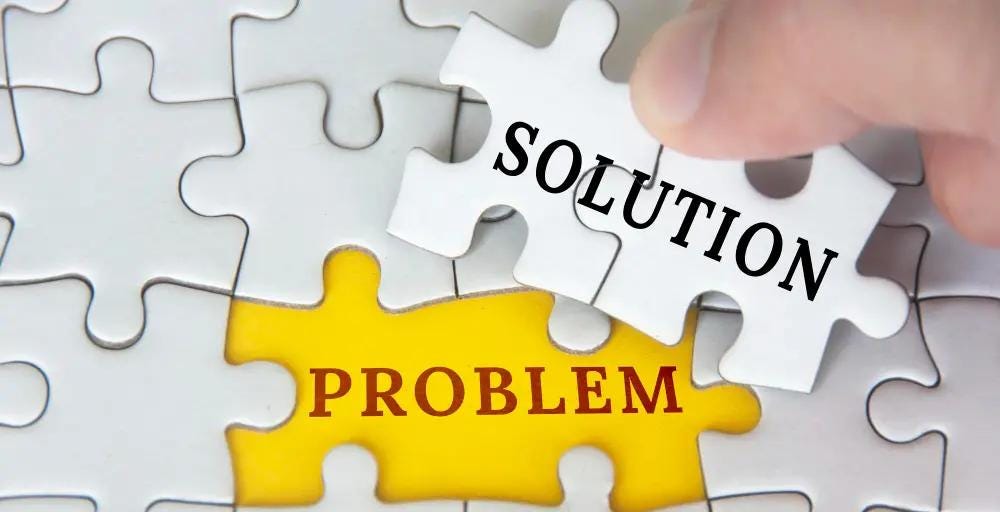Solution Finder or Problem Solver? That is the question!
Great leaders don’t just fix, they reframe, repurpose, and reinvent.
“You never change things by fighting the existing reality. To change something, build a new model that makes the existing model obsolete.”
Buckminster Fuller
(American architect, systems theorist, writer, designer, inventor, philosopher, and futurist.)
Today in Students of Leadership a short follow-on from last week’s newsletter.
I admit, the difference between problem solving and solution finding is subtle and one could even argue that it’s just a play with words; but there is a powerful distinction that separates solid operators from transformational leaders:
Problem solvers fix what is in front of them, respond to what’s broken.
Solution finders transcend the problem to uncover hidden value, create the new.
“The formulation of the problem is often more essential than its solution, which may be merely a matter of mathematical or experimental skill.”
Albert Einstein
The two steps mindset-shift to become a solution finder
1. From reactive to proactive, 2. From proactive to generative
Take a moment to reflect on the evolution of these capabilities and then look in the mirror to assess where you and your team spend most time and effort:
(Reactive) Most junior people operate in a reactive framework, issues come to them and time is spent in getting things done after the need was identified by someone else. This is not an ideal place to live in. You are primarily told what to do, you are not in the driver’s seat.
(Proactive) As you progress you start thinking more clearly and become better at planning, move to a more proactive framework, you anticipate and prepare ahead of time. You are still working on things that are expected from you, but you can have a higher impact when you operate in this space. You stop being told what to do, now you drive.
(Generative) Operating in this space belongs to a different league. You simultaneously deliver what is expected from you, and you future proof your organization. You find the space to think, you ask better questions, and create the processes to innovate. You find solutions for problems don’t yet exist, and you know they will. Still invisible to most, you create opportunities where trends are emerging. You are in the driver’s seat of the car you build.
"The best way to predict the future is to create it."
Abraham Lincoln
Most people are trained to be Problems solvers: find the root cause, mitigate the impact, and restore order. This is necessary, but not sufficient. Solving a problem can often lock you into the current framing of the issue, but that problem you are working to solve might just be a symptom of much deeper issues, the real problem, an untapped opportunity.
Solution finders, on the other hand, don’t accept the problem’s framing as truth. The are good at pausing and taking a step back to look at the picture calmly. The know they have to think in first principles, they have to invert, they have to frame and reframe… so before moving a hair they first ask:
“What’s really at stake here?”
“What new advantage could this pain unlock?”
“How might this lead us to a better process, business model, smarter structure?”
“Is there a real problem here?” if so, “What problem really needs solving?”
“Why?” “Why?” “Why”
Solution Finders think different:
They redesign the constraints
(instead of fixing within constraints)
They focus on outcome and opportunity
(instead of focusing on cause and effect)
They create systemic elevation
(instead of reacting to symptoms)
They reimagine what could be
(instead of optimizing what is)
They ask “What’s possible?”
(instead of asking “What’s broken?”)
“The best way to solve a problem may be to stop seeing it as one.” Tina Seelig
At the End of The Day, it’s About Strategic Elevation
The best leaders are the ones who spot solutions no one else can see, not the ones that solve most problem. Practice shifting to the “Generative” operating model:
What “problem” are we treating as fixed reality, but it may actually be a poorly framed opportunity?
Where are we solving just symptoms instead of confronting the real issues?
What would this situation look like if we weren’t trying to fix it, but to leapfrog?
Are we playing defense to stay in the game or should we try to reinvent and redesign the rules of the game, or change the game we are in altogether?
Leadership can’t just focus on fixing the system you are in, but on the challenge to reimagine what was built for in the first place.
The most valuable solutions aren’t typically found in the problem you are dealt with, rather they’re hidden in how you choose to analyze it.
P.S. Before I go, here you have “The Treat,” where I share some of the music that made me company while writing … Enjoy as you bid farewell to this post
“Lead yourself, Learn to live. Lead others, Learn to Build.”
If you enjoyed reading this post consider subscribing to the newsletter for free, joining the community and sharing your thoughts.



